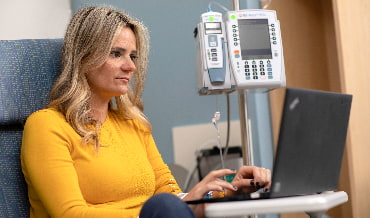Neuromyelitis optica, often shortened to NMO, is an autoimmune disease, which means the immune system attacks its own body’s cells and tissues. It is also called neuromyelitis optica spectrum disorder, or NMOSD.
NMO happens when the immune system damages myelin, the protective layer of protein and fatty substances around nerves. This causes inflammation that can lead to problems in the central nervous system and disrupt messages between the brain and body.
Even though it is like multiple sclerosis, or MS, in many ways, NMO is a more disabling central nervous system disorder. It can lead to optic neuritis, which brings worsening vision or complete blindness.
It can also cause transverse myelitis, which causes symptoms of paralysis or weakness in one or more limbs, stiffness or muscle spasms and loss of bowel or bladder control. And it can cause area postrema syndrome, which includes symptoms of hiccups, nausea or uncontrollable vomiting for several days.
Some common symptoms of neuromyelitis optica include the following:
- Loss of sensation
- Balance issues
- Poor bladder control
- Declining cognition
- Poor mobility
- Loss of vision
These symptoms often come as attacks that can last for days or months, then lessen or stop. Attacks, or relapses, may come months or even years apart. They can leave permanent damage and disability and can lead to other issues.
For example, patients with poor balance, vision and mobility can start to lead more sedentary lives, which can increase their risk for falls or worsen heart and vascular diseases.
Over 40% of people with neuromyelitis optica can become legally blind in at least one eye within five years of the condition first appearing.
Of confirmed diagnosed cases in the United States, the condition has appeared in African Americans and Asians twice as much as Caucasians and nine times more in women than men.
It usually affects people between ages 30 and 50.
Treatment is most effective when it begins as early as possible. Early intervention can slow or stop progression of the disease and prevent disabilities.
The Rush Approach to Neuromyelitis Optica Treatment
At Rush, we start with a complete diagnosis of your condition led by experts in neuroimmunology and related disorders. During your first appointment, you can expect your physician to perform a personal interview to find out information about your unique case.
It’s best to come in with some of this info handy. You may wish to have a partner or someone close to you help gather it. Your physician will ask for the following:
- A list of symptoms you’ve experienced.
- A timeline of when your symptoms first appeared and how they’ve progressed.
- A complete list of medications you take, including prescriptions, over-the-counter medications, medical marijuana, vitamins and supplements.
- Your history of smoking, recreational drug use or exposure to neurotoxins, such as certain heavy metals and chemicals.
- Your family history with neurological disorders.
Your physician will also perform a sensory test to see how your brain responds to lights, sounds and touch.
From there, they will run imaging tests, including an MRI. This will help them see the extent of any damage to your brain or spinal cord and check the health of your optic nerves.
When needed, they may run additional tests to check for infections or antibodies that show a history of infections. These can include blood tests and lumbar punctures.
Once you have a diagnosis, you will have a team of physicians from many different specialties all working together on a care plan that is personalized for your needs and goals.
They will focus on your whole brain health and work to prevent progression of your disease and any disabilities that could result. Their long-term goal is to prevent NMO attacks or relapses and give you the best quality of life possible.
Our neurologists can provide you with all approved medications to treat NMO. This includes the latest infusion therapies. They can also enroll you in clinical trials that can provide access to therapies you may not find at other medical centers.
Your team can also connect you with specialists who can help you manage your condition and lifestyle. These include psychological support services, mental and physical rehabilitation, social services and exercise and nutrition programs to improve and maintain brain health.
Second Opinions for Neuromyelitis Optica Treatment at Rush
Getting a second opinion for an NMO diagnosis or prescribed treatment can help you make decisions about your care with confidence. At Rush, you can expect expert care, access to the latest treatment options and a full team approach to treatment.
To get a second opinion for your NMO, call (888) 352-7874. A care coordinator will help you schedule an appointment with one of our neurologists. They'll review your medical history, imaging and other relevant info to create a custom care plan that's right for you.
You can also visit our appointment page for more options.
Rush Excellence in Neuromyelitis Optica Treatment
- Infusion expertise: At our downtown Chicago location, we have 15 private or semi-private infusion therapy bays and offer a full range of treatments for NMO, including Ocrevus, Solaris and Uplizna, the first FDA-approved treatment for NMO.
- Leaders in care: The Rush MS Center, which houses the Rush Neuroimmunology Clinic, has been recognized as a Center for Comprehensive Care through the National Multiple Sclerosis Society’s Partners in MS Care program.
- Access to clinical trials: We participate in clinical trials and active research that may provide you with treatment options before they become widely available. Our research has played a key role in developing and testing new therapies for neurological conditions.
- Nationally recognized: U.S. News & World Report includes Rush on its Best Hospitals Honor Roll and ranks our neurology program among the nation's best.
FAQs About Neuromyelitis Optica Treatment at Rush
Neuromyelitis optica spectrum disorder refers to an autoimmune disease where the immune system attacks myelin, a protective sheath around nerve cells. This causes lesions and inflammation that affects the spinal cord.
Transverse myelitis is what we call that inflammation. But it can be caused by conditions other than NMOSD, including multiple sclerosis and anti-myelin oligodendrocyte glycoprotein (anti-MOG) syndromes.
Many of the therapies for NMO involve medications that suppress the immune system response. This is because the immune system is attacking the body’s own cells and tissue. While these medications prevent NMO attacks, they may also leave patients at higher risk for infections.
A neuroimmunologist or neurologist who specializes in neuroimmune disorders treats NMO. At Rush, your neuroimmunologist will work with a team of specialists from many other fields to create your care plan and address your whole brain health.
The cause of NMO is unknown. But there are some things that increase the risk.
The majority of people with NMO have antibodies that target aquaporin-4, or AQP4. It’s a protein that moves water in and out of cells. AQP4 antibodies signal the immune system to attack cells that carry the protein.
But many people with NMO do not have these antibodies. Further research into the causes of NMO is ongoing.
NMO is not a curable condition. But early intervention and treatment can stop progression of the disease, prevent disability and prevent relapses. The goal is to maintain or improve your quality of life.
The life expectancy of patients with NMO will vary a great deal from person to person. Without treatment, it often leads to worsening disability and can shorten life expectancy. But with effective treatment, life expectancy for a patient with NMO is the same as a person who does not have the condition, and progression of disability can often be slowed or stopped, leading to greater quality of life.







